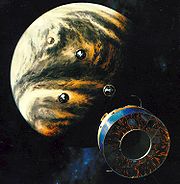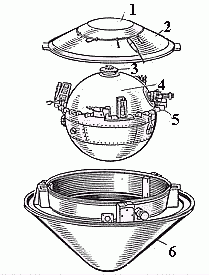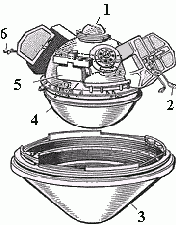
Pioneer Venus project
Encyclopedia
The Pioneer mission to Venus
consisted of two components, launched separately. Pioneer Venus 1 or Pioneer Venus Orbiter was launched in 1978 and studied the planet for more than a decade after orbital insertion in 1978. Pioneer Venus 2 or Pioneer Venus Multiprobe sent four small probes into the Venusian atmosphere. This was managed by NASA Ames Research Center
as part of the Pioneer series of spacecraft that included Pioneer 10
and Pioneer 11
.
The Pioneer Venus Orbiter was inserted into an elliptical orbit around Venus on December 4, 1978. The Orbiter was a flat cylinder 2.5 m in diameter and 1.2 m high. All instruments and spacecraft subsystems were mounted on the forward end of the cylinder, except the magnetometer
, which was at the end of a 4.7 m boom. A solar array
extended around the circumference of the cylinder. A 1.09 m despun dish antenna provided S
and X band
communication with Earth
. It was manufactured by Hughes Aircraft Company.
The Pioneer Venus Orbiter carried 17 experiments (with a total mass of 45 kg):
From Venus orbit insertion to July 1980, periapsis was held between 142 and 253 km (at 17 degrees north latitude) to facilitate radar and ionospheric measurements. The spacecraft was in a 24 hour orbit with an apoapsis of 66,900 km. Thereafter, the periapsis was allowed to rise (to 2290 km at maximum) and then fall, to conserve fuel. In 1991 the Radar Mapper was reactivated to investigate previously inaccessible southern portions of the planet, in conjunction with the recently-arrived Magellan probe
. In May 1992 Pioneer Venus began the final phase of its mission, in which the periapsis was held between 150 and 250 km, until the fuel ran out and atmospheric entry destroyed the spacecraft the following August.


The Pioneer Venus Multiprobe consisted of a bus which carried one large and three small atmospheric probes. None of these atmospheric probes had photographic imaging capabilities and were not designed for soil analysis. They were not even designed for a soft landing; the large probe had a parachute that was designed to cut loose at a certain altitude, and the small probes had no parachute at all. Survival to the surface was considered a bonus. All the entry probes survived the density of the Venusian atmosphere at least until impact, but only one probe survived for a significant period after impact.
The large probe was released on November 16, 1978 and the three small probes on November 20. All four probes entered the Venusian atmosphere on December 9, followed by the bus.
The bus was a 2.5 m diameter cylinder weighing 290 kg, and afforded us our only direct view of the upper Venus atmosphere, as the probes did not begin making direct measurements until they had decelerated lower in the atmosphere.
With no heat shield
or parachute
, the bus made upper atmospheric measurements with two instruments, an Ion Mass Spectrometer (BIMS) and a Neutral Mass Spectrometer (BNMS), down to an altitude of about 110 km before disintegrating on December 9, 1978.
 The Pioneer Venus Large probe was equipped with 7 science experiments, contained within a sealed spherical pressure vessel. The science experiments were:
The Pioneer Venus Large probe was equipped with 7 science experiments, contained within a sealed spherical pressure vessel. The science experiments were:
This pressure vessel was encased in a nose cone and aft protective cover. After deceleration from initial atmospheric entry at about 11.5 km/s near the equator on the Venus night side, a parachute
was deployed at 47 km altitude. The large probe was about 1.5 m in diameter and the pressure vessel itself was 73.2 cm in diameter.
 The three small probes were identical to each other, 0.8 m in diameter. These probes also consisted of spherical pressure vessels surrounded by an aeroshell, but unlike the large probe, they had no parachutes and the aeroshells did not separate from the probe.
The three small probes were identical to each other, 0.8 m in diameter. These probes also consisted of spherical pressure vessels surrounded by an aeroshell, but unlike the large probe, they had no parachutes and the aeroshells did not separate from the probe.
Each small probe carried a nephelometer and temperature, pressure, and acceleration sensors, as well as a net flux radiometer experiment to map the distribution of sources and sinks of radiative energy in the atmosphere. The radio signals from all four probes were also used to characterize the winds, turbulence, and propagation in the atmosphere.
The small probes were each targeted at different parts of the planet and were named accordingly.
Venus
Venus is the second planet from the Sun, orbiting it every 224.7 Earth days. The planet is named after Venus, the Roman goddess of love and beauty. After the Moon, it is the brightest natural object in the night sky, reaching an apparent magnitude of −4.6, bright enough to cast shadows...
consisted of two components, launched separately. Pioneer Venus 1 or Pioneer Venus Orbiter was launched in 1978 and studied the planet for more than a decade after orbital insertion in 1978. Pioneer Venus 2 or Pioneer Venus Multiprobe sent four small probes into the Venusian atmosphere. This was managed by NASA Ames Research Center
NASA Ames Research Center
The Ames Research Center , is one of the United States of America's National Aeronautics and Space Administration 10 major field centers.The centre is located in Moffett Field in California's Silicon Valley, near the high-tech companies, entrepreneurial ventures, universities, and other...
as part of the Pioneer series of spacecraft that included Pioneer 10
Pioneer 10
Pioneer 10 is a 258-kilogram robotic space probe that completed the first interplanetary mission to Jupiter, and became the first spacecraft to achieve escape velocity from the Solar System. The project was managed by the NASA Ames Research Center and the contract for the construction of the...
and Pioneer 11
Pioneer 11
Pioneer 11 is a 259-kilogram robotic space probe launched by NASA on April 6, 1973 to study the asteroid belt, the environment around Jupiter and Saturn, solar wind, cosmic rays, and eventually the far reaches of the solar system and heliosphere...
.
Pioneer Venus Orbiter
- Launch date: May 20, 1978
- Launch vehicle: Atlas-CentaurAtlas-CentaurThe Atlas-Centaur was an American expendable launch system designed and built by General Dynamics Convair Division in San Diego, CA. It was derived from the SM-65 Atlas missile. It was a member of the Atlas family of rockets, and was used for 61 orbital launches between 1962 and 1983. It was...
- On-orbit mass: 517 kg
- Power system: solar array of 312 W
The Pioneer Venus Orbiter was inserted into an elliptical orbit around Venus on December 4, 1978. The Orbiter was a flat cylinder 2.5 m in diameter and 1.2 m high. All instruments and spacecraft subsystems were mounted on the forward end of the cylinder, except the magnetometer
Magnetometer
A magnetometer is a measuring instrument used to measure the strength or direction of a magnetic field either produced in the laboratory or existing in nature...
, which was at the end of a 4.7 m boom. A solar array
Photovoltaic module
A solar panel is a packaged, connected assembly of solar cells, also known as photovoltaic cells...
extended around the circumference of the cylinder. A 1.09 m despun dish antenna provided S
S band
The S band is defined by an IEEE standard for radio waves with frequencies that range from 2 to 4 GHz, crossing the conventional boundary between UHF and SHF at 3.0 GHz. It is part of the microwave band of the electromagnetic spectrum...
and X band
X band
The X band is a segment of the microwave radio region of the electromagnetic spectrum. In some cases, such as in communication engineering, the frequency range of X band is rather indefinitely set at approximately 7.0 to 11.2 gigahertz . In radar engineering, the frequency range is specified...
communication with Earth
Earth
Earth is the third planet from the Sun, and the densest and fifth-largest of the eight planets in the Solar System. It is also the largest of the Solar System's four terrestrial planets...
. It was manufactured by Hughes Aircraft Company.
The Pioneer Venus Orbiter carried 17 experiments (with a total mass of 45 kg):
- a cloud photo-polarimeter (OCPP) to measure the vertical distribution of the cloudCloudA cloud is a visible mass of liquid droplets or frozen crystals made of water and/or various chemicals suspended in the atmosphere above the surface of a planetary body. They are also known as aerosols. Clouds in Earth's atmosphere are studied in the cloud physics branch of meteorology...
s, similar to Pioneer 10Pioneer 10Pioneer 10 is a 258-kilogram robotic space probe that completed the first interplanetary mission to Jupiter, and became the first spacecraft to achieve escape velocity from the Solar System. The project was managed by the NASA Ames Research Center and the contract for the construction of the...
and Pioneer 11Pioneer 11Pioneer 11 is a 259-kilogram robotic space probe launched by NASA on April 6, 1973 to study the asteroid belt, the environment around Jupiter and Saturn, solar wind, cosmic rays, and eventually the far reaches of the solar system and heliosphere...
imaging photo-polarimeter (IPP) - a surface radar mapper (ORAD) to determine topography and surface characteristics. Observations could only be conducted when the probe was closer than 4700 km over the planet. A 20 Watt S-band signal (1.757 gigahertz) was sent to the surface that reflected it, with the probe analyzing the echo. Resolution at periapsis was 23 x 7 km.
- an infrared radiometer (OIR) to measure IRInfraredInfrared light is electromagnetic radiation with a wavelength longer than that of visible light, measured from the nominal edge of visible red light at 0.74 micrometres , and extending conventionally to 300 µm...
emissions from Venus' atmosphere - an airglow ultravioletUltravioletUltraviolet light is electromagnetic radiation with a wavelength shorter than that of visible light, but longer than X-rays, in the range 10 nm to 400 nm, and energies from 3 eV to 124 eV...
spectrometer (OUVS) to measure scattered and emitted UV light - a neutral mass spectrometer (ONMS) to determine the composition of the upper atmosphere
- a solar windSolar windThe solar wind is a stream of charged particles ejected from the upper atmosphere of the Sun. It mostly consists of electrons and protons with energies usually between 1.5 and 10 keV. The stream of particles varies in temperature and speed over time...
plasmaPlasma (physics)In physics and chemistry, plasma is a state of matter similar to gas in which a certain portion of the particles are ionized. Heating a gas may ionize its molecules or atoms , thus turning it into a plasma, which contains charged particles: positive ions and negative electrons or ions...
analyzer (OPA) to measure properties of the solar wind - a magnetometer (OMAG) to characterize the magnetic fieldMagnetic fieldA magnetic field is a mathematical description of the magnetic influence of electric currents and magnetic materials. The magnetic field at any given point is specified by both a direction and a magnitude ; as such it is a vector field.Technically, a magnetic field is a pseudo vector;...
at Venus - an electric field detector (OEFD) to study the solar wind and its interactions
- an electronElectronThe electron is a subatomic particle with a negative elementary electric charge. It has no known components or substructure; in other words, it is generally thought to be an elementary particle. An electron has a mass that is approximately 1/1836 that of the proton...
temperature probe (OETP) to study the thermal properties of the ionosphereIonosphereThe ionosphere is a part of the upper atmosphere, comprising portions of the mesosphere, thermosphere and exosphere, distinguished because it is ionized by solar radiation. It plays an important part in atmospheric electricity and forms the inner edge of the magnetosphere... - an ion mass spectrometer (OIMS) to characterize the ionospheric ion population
- a charged particle retarding potential analyzer (ORPA) to study ionospheric particles
- two radioRadioRadio is the transmission of signals through free space by modulation of electromagnetic waves with frequencies below those of visible light. Electromagnetic radiation travels by means of oscillating electromagnetic fields that pass through the air and the vacuum of space...
science experiments to determine the gravity field of Venus - a radio occultation experiment to characterize the atmosphere
- an atmospheric drag experiment to study the upper atmosphere
- a radio science atmospheric and solar wind turbulenceTurbulenceIn fluid dynamics, turbulence or turbulent flow is a flow regime characterized by chaotic and stochastic property changes. This includes low momentum diffusion, high momentum convection, and rapid variation of pressure and velocity in space and time...
experiment - a gamma ray burstGamma ray burstGamma-ray bursts are flashes of gamma rays associated with extremely energetic explosions that have been observed in distant galaxies. They are the most luminous electromagnetic events known to occur in the universe. Bursts can last from ten milliseconds to several minutes, although a typical...
(OGBD) detector to record gamma ray burst events
From Venus orbit insertion to July 1980, periapsis was held between 142 and 253 km (at 17 degrees north latitude) to facilitate radar and ionospheric measurements. The spacecraft was in a 24 hour orbit with an apoapsis of 66,900 km. Thereafter, the periapsis was allowed to rise (to 2290 km at maximum) and then fall, to conserve fuel. In 1991 the Radar Mapper was reactivated to investigate previously inaccessible southern portions of the planet, in conjunction with the recently-arrived Magellan probe
Magellan probe
The Magellan spacecraft, also referred to as the Venus Radar Mapper, was a 1,035-kilogram robotic space probe launched by NASA on May 4, 1989, to map the surface of Venus using Synthetic Aperture Radar and measure the planetary gravity...
. In May 1992 Pioneer Venus began the final phase of its mission, in which the periapsis was held between 150 and 250 km, until the fuel ran out and atmospheric entry destroyed the spacecraft the following August.
Pioneer Venus Multiprobe


- Launch date: August 8, 1978
- Launch vehicle: Atlas-Centaur
- Mass: 290 kg (bus), 315 kg (large probe), 90 kg (each small probe)
- Power system: solar array of 241 W (bus); batteries (probes)
The Pioneer Venus Multiprobe consisted of a bus which carried one large and three small atmospheric probes. None of these atmospheric probes had photographic imaging capabilities and were not designed for soil analysis. They were not even designed for a soft landing; the large probe had a parachute that was designed to cut loose at a certain altitude, and the small probes had no parachute at all. Survival to the surface was considered a bonus. All the entry probes survived the density of the Venusian atmosphere at least until impact, but only one probe survived for a significant period after impact.
The large probe was released on November 16, 1978 and the three small probes on November 20. All four probes entered the Venusian atmosphere on December 9, followed by the bus.
| Large Probe | North Probe | Day Probe | Night Probe | Bus | |
|---|---|---|---|---|---|
| Entry time (200 km) | 18:45:32 | 18:49:40 | 18:52:18 | 18:56:13 | 20:21:52 |
| Impact time | 19:39:53 | 19:42:40 | 19:47:59 | 19:52:05 | (signal lost at 110 km altitude) |
| Loss of signal | 19:39:53 | 19:42:40 | 20:55:34 | 19:52:07 | 20:22:55 |
| Impact coordinates | (estimated) | ||||
| Solar Zenith Angle | 65.7 | 108.0 | 79.9 | 150.7 | 60.7 |
| Local Venus time | 7:38 | 3:35 | 6:46 | 0:07 | 8:30 |
Bus
The Pioneer Venus bus portion of the spacecraft was targeted to enter the Venusian atmosphere at a shallow entry angle and transmit data until destruction by the heat of atmospheric friction. The objective was to study the structure and composition of the atmosphere down to the surface, the nature and composition of the clouds, the radiation field and energy exchange in the lower atmosphere, and local information on the atmospheric circulation pattern.The bus was a 2.5 m diameter cylinder weighing 290 kg, and afforded us our only direct view of the upper Venus atmosphere, as the probes did not begin making direct measurements until they had decelerated lower in the atmosphere.
With no heat shield
Heat shield
A heat shield is designed to shield a substance from absorbing excessive heat from an outside source by either dissipating, reflecting or simply absorbing the heat...
or parachute
Parachute
A parachute is a device used to slow the motion of an object through an atmosphere by creating drag, or in the case of ram-air parachutes, aerodynamic lift. Parachutes are usually made out of light, strong cloth, originally silk, now most commonly nylon...
, the bus made upper atmospheric measurements with two instruments, an Ion Mass Spectrometer (BIMS) and a Neutral Mass Spectrometer (BNMS), down to an altitude of about 110 km before disintegrating on December 9, 1978.
Large probe

- a neutral mass spectrometer to measure the atmospheric composition
- a gas chromatograph to measure the atmospheric composition
- a solar flux radiometer to measure solar flux penetration in the atmosphere
- an infrared radiometer to measure distribution of infrared radiation
- a cloud particle size spectrometer to measure particle size and shape
- a nephelometerNephelometerA nephelometer is a stationary or portable instrument for measuring suspended particulates in a liquid or gas colloid. A nephelometer measures suspended particulates by employing a light beam and a light detector set to one side of the source beam. Particle density is then a function of the...
to search for cloud particles - temperature, pressure, and acceleration sensors
This pressure vessel was encased in a nose cone and aft protective cover. After deceleration from initial atmospheric entry at about 11.5 km/s near the equator on the Venus night side, a parachute
Parachute
A parachute is a device used to slow the motion of an object through an atmosphere by creating drag, or in the case of ram-air parachutes, aerodynamic lift. Parachutes are usually made out of light, strong cloth, originally silk, now most commonly nylon...
was deployed at 47 km altitude. The large probe was about 1.5 m in diameter and the pressure vessel itself was 73.2 cm in diameter.
Small probes

Each small probe carried a nephelometer and temperature, pressure, and acceleration sensors, as well as a net flux radiometer experiment to map the distribution of sources and sinks of radiative energy in the atmosphere. The radio signals from all four probes were also used to characterize the winds, turbulence, and propagation in the atmosphere.
The small probes were each targeted at different parts of the planet and were named accordingly.
- The North probe entered the atmosphere at about 60 degrees north latitude on the day side.
- The Night probe entered on the night side.
- The Day probe entered well into the day side, and was the only one of the four probes which continued to send radio signals back after impact, for over an hour.
Halley's Comet in 1986
Pioneer Venus Orbiter orbiting Venus had a front row seat when Halley's Comet was more or less hidden behind the Sun during February 1986. Its UV-spectrometer observed the water loss when Halley's Comet was at perihelion February 9.External links
- NASA: Pioneer Venus Project Information
- Pioneer Venus Program Page by NASA's Solar System Exploration
- NSSDC Master Catalog: Spacecraft Pioneer Venus Probe Bus. (Other components of the mission have their own pages at this site too.)
- Several articles in Science (1979), 205, pages 41-121
- Kasprzak, W. T - The Pioneer Venus Orbiter: 11 years of data. (May 1, 1990) - NASA

